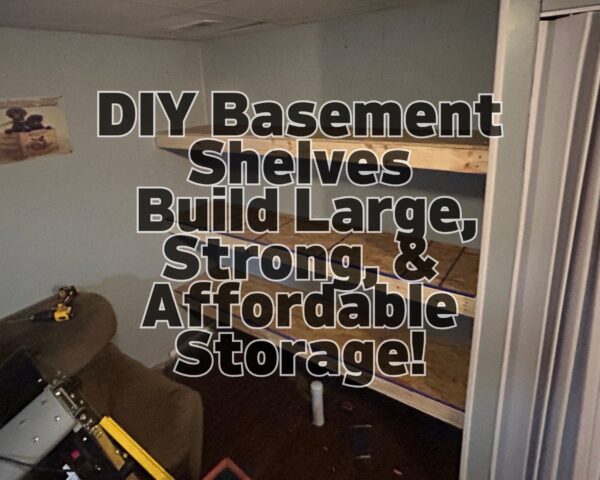Are you looking to maximize storage space in your basement on a budget? Building your own shelves can be a rewarding and cost-effective solution. Especially if you have a basement with a concrete wall, creating sturdy and functional shelving might seem challenging, but it’s entirely doable with the right approach. In this article, I’ll guide you through the process of building large, strong, and affordable basement shelves, perfect for any DIY enthusiast or homeowner.

Choosing the Right Materials
The first step in any DIY project is selecting the right materials. For basement shelves, you want materials that are durable, strong, and resistant to moisture. Pressure-treated lumber or plywood are great options for the shelving itself, while metal brackets and concrete anchors will ensure your shelves are securely fastened to the wall.
Measuring and Planning Your Shelving Layout
Before you start building, it’s crucial to measure your space and plan your shelving layout. Consider the items you plan to store and ensure your shelves are spaced accordingly. Don’t forget to leave enough room for easy access and movement around the basement.
Anchoring Shelves to a Concrete Wall
Anchoring shelves to a concrete wall requires specific hardware and tools. You’ll need a hammer drill, concrete anchors, and possibly a masonry bit. Mark your drilling points carefully, ensuring they align with the studs in your shelving frame for maximum stability.
Tips for a Professional Finish
To achieve a professional finish, sand your shelves smoothly and consider applying a coat of paint or wood stain. Not only will this enhance the look of your shelves, but it can also add an extra layer of protection against moisture and wear. Although I am not a professional, I am your normal American guy who has experience with many kinds of tools and DIY home things.
Cost-Effective Solutions
Building your own shelves can be much more affordable than buying pre-made units. By choosing budget-friendly materials and doing the work yourself, you can save a significant amount of money while achieving a custom storage solution that perfectly fits your space and needs.

I’m excited to share this DIY basement shelving project with you. It’s a practical, affordable, and satisfying way to improve your home’s storage capacity. If you’re ready to tackle this project, don’t forget to check out my step-by-step video tutorial for more detailed guidance.
What materials are best for building DIY basement shelves?
For sturdy and affordable basement shelves, materials like plywood, 2x4s, or MDF (Medium-Density Fiberboard) are popular choices. Plywood and MDF provide a good balance between strength, cost, and ease of work. Ensure the wood is treated or sealed to prevent moisture damage, which is crucial in basement environments.
How do I determine the right size for my basement shelves?
The size of your basement shelves should be based on the available space and your storage needs. Measure the area where you plan to install the shelves, considering both the width and height. Leave enough room for easy access and movement around the shelves. Also, consider the size of the items you plan to store.
What tools do I need to build basement shelves?
Basic tools for building basement shelves include a measuring tape, a level, a saw (hand saw, circular saw, or table saw), a drill with bits, screws, a hammer, and potentially a stud finder if you’re attaching the shelves to the wall. Safety equipment like goggles and gloves are also essential.
How can I ensure my basement shelves are strong enough?
To ensure strength, use sturdy materials like thick plywood or solid wood for the shelves. Support the shelves with robust vertical supports and horizontal braces. Secure the shelves to wall studs if possible for added stability. Also, distribute weight evenly across the shelves.
Can I build adjustable shelving in my basement?
Yes, adjustable shelving is a great option for basements. Use metal tracks and brackets or drill a series of holes along the shelf supports to allow for adjustable shelf heights. This flexibility is useful for storing items of various sizes.
How do I protect my shelves from basement moisture?
To protect against moisture, use treated wood or seal your wooden shelves with a waterproof sealant. Ensure good ventilation in your basement to reduce humidity levels. Keeping shelves off the floor can also prevent moisture absorption.
Is it necessary to anchor basement shelves to the wall?
Anchoring shelves to the wall is recommended for safety, especially for tall or heavily loaded shelves. This prevents tipping and adds overall stability. Use appropriate wall anchors and screws for secure attachment.
What is the most cost-effective way to build basement shelves?
The most cost-effective approach is to use affordable materials like plywood or MDF and build the shelves yourself. Design the shelves to minimize waste. Look for sales or discounts at local hardware stores, or consider repurposing or recycling materials.
How can I customize my basement shelves for specific storage needs?
Customize your shelves by adjusting the size and number of shelves based on what you plan to store. Add features like bins, hooks, or drawers for small items. Consider painting or staining the shelves to match your basement’s decor.
Are there any safety concerns I should be aware of when building basement shelves?
Safety concerns include ensuring the shelves are stable and securely anchor
ed to prevent tipping. Be cautious with power tools and wear appropriate safety gear. Also, consider the weight capacity of your shelves to avoid overloading.

- Modern Yet Rustic Home with a Wrap-Around Porch: Explore the charm of a modern yet rustic home, especially one adorned with a huge wrap-around porch. 🔗 Read More
- Essential Home Maintenance Tips for New Homeowners: Congratulations on becoming a homeowner! This article provides regular maintenance tips to keep your investment in excellent condition. 🔗 Learn More
As an Amazon Associate we earn from qualifying purchases through some links in our articles.



